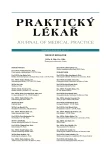Significant aortic stenosis in routine clinical practice
Authors:
J. Vondrák; P. Vojtíšek
Authors‘ workplace:
Kardiologické oddělení
; Primář: MUDr. Petr Vojtíšek, CSc.
; Pardubická krajská nemocnice a. s., Pardubice
Published in:
Prakt. Lék. 2012; 92(5): 280-283
Category:
Of different specialties
Overview
The aim of our study
was to obtain baseline characteristics of the patients referred to our centre for overall evaluation for significant aortic stenosis. We analysed 100 consecutive patients comprehensively examined for significant aortic stenosis between March 2009 and August 2010. The average age was 71 years, males predominated (59%). The dominant symptoms were dyspnoea and chest pain. Major cardiovascular risk factors associated with aortic stenosis were arterial hypertension, hyperlipidaemia, diabetes mellitus and smoking habits. Significant coronary disease was diagnosed in 49 cases. Echocardiography revealed bicuspid aortic valve in 26 patients, in 19 we were unable to determine the number of cusps. The mean indexed aortic valve orifice area was 0.43 cm2/m2, left ventricular EF 59%. Interventricular septal thickness average 12 mm, estimated systolic pulmonary artery pressure 46 mm Hg, the average size of ascending aorta was 35.8 mm. Patients with bicuspid aortic valve were younger and had larger ascending aorta (40 vs. 34 mm). There was no other difference in the tested parameters between these groups. 74 patients underwent valvular correction. Biological prosthesis was implanted most frequently, in two cases the valve was implanted in a percutaneous approach. We checked all patients’ health status by telephone in December 2010. Patients who underwent surgery indicated an improvement in their symptoms. Nobody died in this group. In contrast, patients treated conservatively were more symptomatic and we recorded 4 deaths. In summary aortic stenosis is associated with an adverse cardiovascular risk profile. Half of patients with severe aortic stenosis have significant stenosis of coronary arteries. Patients with bicuspid aortic valve are younger, with a tendency to dilatation of the ascending aorta. The only way to reduce symptoms and improve prognosis is aortic valve replacement.
Key words:
aortic stenosis, coronary disease, valvular correction
Sources
1. Otto, CM, Kuusisto, I, Reichenbach, DD, et al. Characterization of the early lesion of degenerative valvular aortic stenosis: histological and immunohistochemical studies. Circulation, 1994, 90, p. 844–853.
2. Yilmaz, MB, Guray, U, Guray, Y, et al. Lipid profile of patient with aortic stenosis might be predictive of rate of progression. Am Heart J, 2004, 147, p. 915–918.
3. Čerbák, R., a kol. Nejčastější chlopenní vady. Aortální stenóza a mitrální regurgitace. Praha: Galén, 2007, s. 13–14, 111–125.
4. Vojáček, J., Kettner, J., a kol. Klinická kardiologie. Hradec Králové: Nucleus HK, 2009, s. 494–495.
5. Čerbák, R. Aortální stenóza – nejčastější chlopenní vada současnosti. Cor Vasa 2005; 47: 409–411.
6. Popelová J, Benešová M, Brtko M, a kol. Doporučené postupy pro diagnostiku a léčbu chlopenních srdečních vad v dospělosti. Cor Vasa 2007; 49 (Suppl 11): s. 6–46.
7. Aschermann M, Widimský P, Veselka J, a kol. Kardiologie. Praha: Galén, 2004, s. 797–804.
8. Roberts, WC, Ko, JM. Frequency by decades of unicuspid, bicuspid,and tricuspid aortic valves in adults having isolated aortic valve replacement for aortic stenosis, with or without associated aortic regurgitation. Circulation, 2005, 111, p. 920–925.
9. Želízko J. Slovo úvodem. Interv Akut Kardiol 2010; 9(Suppl. B): s. 4.
10. Vojáček J, Želízko M, Černý J, et al. Podmínky pro katetrizační implantaci aortální chlopně v České republice. Společný dokument pracovní skupiny České kardiologické společnosti a České společnosti kardiovaskulární chirurgie. Cor Vasa 2009; 51(9): s. 617–618.
Labels
General practitioner for children and adolescents General practitioner for adultsArticle was published in
General Practitioner

2012 Issue 5
Most read in this issue
- REM behavior disorder – a neglected diagnosis
- Eosinophilic pneumonia and systemic vasculitis
- Atypical course of pneumonia with extrapulmonary complications due to Mycoplasma pneumoniae infection
- Significant aortic stenosis in routine clinical practice
